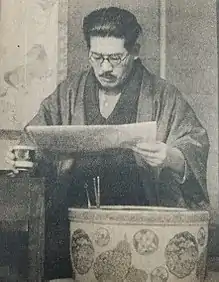Inejirō Asanuma
Inejiro Asanuma (浅沼 稲次郎, Asanuma Inejirō, 27 December 1898 – 12 October 1960) was a Japanese politician and leader of the Japan Socialist Party. Asanuma became a forceful advocate of socialism in post-war Japan. He was noted for his support of the Chinese Communist Party, and his criticism of U.S–Japanese relations, which were particularly controversial.
Inejiro Asanuma | |
|---|---|
 Asanuma in 1948 | |
| 1st General Secretary of the Japan Socialist Party | |
| In office 13 October 1955 – 23 March 1960 | |
| Preceded by | Position created |
| Succeeded by | Jōtarō Kawakami |
| 3rd Chairman of the Japan Socialist Party | |
| In office 23 March 1960 – 12 October 1960 | |
| Preceded by | Suzuki Mosaburō |
| Succeeded by | Jōtarō Kawakami |
| Member of the Japanese House of Representatives from Tokyo 1st district | |
| In office 11 April 1946 – 12 October 1960 | |
| In office 21 February 1936 – 30 April 1942 | |
| Personal details | |
| Born | 27 December 1898 Miyake-jima, Tokyo, Japan |
| Died | 12 October 1960 (aged 61) Chiyoda, Tokyo, Japan |
| Cause of death | Assassination (stab wound) |
| Resting place | Tama Cemetery, Tokyo, Japan |
| Political party | Japan Socialist |
| Alma mater | Waseda University |
| Occupation | Politician |
Asanuma was assassinated with a yoroi-dōshi, a traditional sword,[1] by ultranationalist Otoya Yamaguchi while speaking in a televised political debate in Tokyo. His violent death was seen in graphic detail on national television, causing widespread public shock and outrage.
Early life
Asanuma was born on the island of Miyake-jima, a remote volcanic island that is administratively part of Tokyo, on 27 December 1898.[2] His mother died during his birth, leaving him to be raised by his father, who later died of cancer at the age of 42.[3]
Political career
He served in the Diet from 1936. He grew dissatisfied with the direction World War II was taking[2] and withdrew his candidacy from the 1942 election and retired from politics until after Japan's defeat.[3] He later returned to politics as a socialist and left-wing activist.[2]
Asanuma was widely criticized for a 1959 incident in which he visited Communist China and called the United States "the shared enemy of China and Japan" during a speech in Beijing. When he returned from this trip he wore a Mao suit while disembarking from a plane in Japan, sparking criticism even from Socialist leaders.[3] At this time, Japan, its ally the United States, and many other countries recognized the Republic of China as the legitimate government over China.[4]
Assassination

On 12 October 1960, Asanuma was assassinated by 17-year-old Otoya Yamaguchi, a nationalist, during a televised political debate for the coming elections for the House of Representatives. While Asanuma spoke from the lectern at Tokyo's Hibiya Hall, Yamaguchi rushed onstage and ran his wakizashi (a traditional samurai short sword) through Asanuma's ribs on the left side, fatally wounding him. Japanese television company NHK was videorecording the debate for later transmission and the tape of Asanuma's assassination was shown many times to millions of viewers.[6][7] The photograph of Asanuma's assassination won its photographer Yasushi Nagao both the Pulitzer Prize and World Press Photo of the Year.[2]
Yamaguchi was captured at the scene of the crime, and a few weeks afterwards committed suicide by hanging while in police custody.[8]
References
- "Using a traditional blade, 17-year-old Yamaguchi assassinates politician Asanuma in Tokyo, 1960". rarehistoricalphotos.com. Retrieved 12 October 2018.
- Newton 2014, p. 234.
- 鶴崎友亀『浅沼稲次郎小伝』(たいまつ新書、1979年)1998年に新時代社より復刻。ISBN 4167209047(復刻版)
- Michael Y.M. Kao, "Taiwan's and Beijing's Campaigns for Unification," in Harvey Feldman, Michael Y.M. Kao, eds., Taiwan in a Time of Transition (New York: Paragon House, 1988), 188.
- Zelizer, Barbie (2010). About to Die: How News Images Move the Public. Oxford: Oxford University Press. p. 183. ISBN 0199752133. Retrieved 18 August 2012.
- Chun, Jayson Makoto (2006). A Nation of a Hundred Million Idiots?: A Social History of Japanese Television, 1953–1973. Routledge. pp. 184–185. ISBN 978-0-415-97660-2. Retrieved 22 March 2014.
- Langdon, Frank (1973). Japan's Foreign Policy. Vancouver: University of British Columbia Press. p. 19. ISBN 0774800151. Retrieved 18 August 2012.
- "Leftist's Killer Suicide in Japan" (PDF). The New York Times. 3 November 1960. Retrieved 17 April 2013.
Works cited
- Newton, Michael (2014). "Inejiro Asanuma (1898–1960)". Famous Assassinations in World History: An Encyclopedia [2 volumes]. ABC-CLIO. pp. 234–235. ISBN 978-1-61069-286-1.
External links
- Inejirō Asanuma at Find a Grave
- Video of Inejiro Asanuma assassination (Warning: may disturb some viewers) on YouTube
| Party political offices | ||
|---|---|---|
| Preceded by Mosaburō Suzuki |
Chair of the Japan Socialist Party 1960 |
Succeeded by Saburō Eda |
| Preceded by N/A |
General Secretary of the Japan Socialist Party 1955–1960 | |
| Preceded by New post |
General Secretary of the Farmer-Labour Party 1925 |
Succeeded by Party banned |
